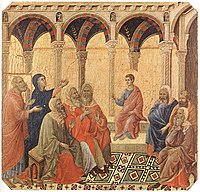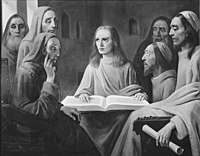Finding in the Temple

| Events in the |
| Life of Jesus according to the canonical gospels |
|---|
 |
|
Portals: |
The Finding in the Temple, also called Christ among the Doctors or the Disputation (the usual names in art), was an episode in the early life of Jesus depicted in chapter 2 of the Gospel of Luke. It is the only event of the later childhood of Jesus mentioned in a gospel.[1]
Gospel account[]
The episode is described in Luke 2:41–52. Jesus at the age of twelve accompanies Mary and Joseph, and a large group of their relatives and friends to Jerusalem on pilgrimage, "according to the custom" – that is, Passover. On the day of their return, Jesus "lingered" /stayed in the Temple, but Mary and Joseph thought that he was among their group when he wasn't. Mary and Joseph headed back home and after a day of travel realised Jesus was missing, so they returned to Jerusalem, finding Jesus three days later.[2] He was found in The Temple in discussion with the elders. They were amazed at his learning, especially given his young age. When admonished by Mary, Jesus replied: "How is it that you sought me? Did you not know that I must be in my Father's house?"[3]
The story was slightly elaborated in later literature, such as the apocryphal 2nd-century Infancy Gospel of Thomas (19:1–12). The losing of Jesus is the third of the Seven Sorrows of Mary, and the Finding in the Temple is the fifth Joyful Mystery of the Rosary.[1]
In art[]

This event is frequently shown in art, and was a common component in cycles of the Life of the Virgin as well as the Life of Christ. In early Christian depictions, Jesus is usually shown in the center, seated on a raised dais surrounded by the elders, who are often on stepped benches. The gesture usually made by Jesus, pointing to his upraised thumb (illustration), may be a conventional rhetorical gesture expressing the act of expounding text. These depictions derive from classical compositions of professors of philosophy or rhetoric with their students, and are similar to medieval depictions of contemporary university lectures.
This composition can appear until as late as Ingres (Montauban, Musée Ingres [1]) and beyond. From the Early Medieval period the moment shown is usually assimilated to the finding itself, by the inclusion of, initially, Mary, and later Joseph as well, usually at the left of the scene. Typically, Jesus and the doctors, intent on their discussions, have not noticed them yet. From the 12th century Jesus is often seated in a large throne-like chair, sometimes holding a book or scroll.
In late medieval depictions, the Doctors, often now carrying or consulting large volumes, may be given specifically Jewish features or dress, and are sometimes overtly anti-Semitic caricatures, like some of the figures in Albrecht Dürer's version in the Thyssen-Bornemisza Museum in Madrid. From the High Renaissance onward, many painters showed a "close-up" of the scene, with Jesus closely surrounded by gesticulating scholars, as in Dürer's version of the subject.
Rembrandt, who enjoyed depicting Jewish elders in the Temple in various subjects, made three etchings of the subject (Bartsch 64–66) as well as one of the much more unusual scene of "Jesus returning from the Temple with his parents" (B 60). The Pre-Raphaelite painter William Holman Hunt painted a version called The Finding of the Saviour in the Temple, now at Birmingham, as one of a number of subjects from Jesus's life, for which he travelled to the Holy Land to study local details.
The subject has attracted few artists since the 19th century, and one of the last notable depictions may be the one painted, as a forgery of a Vermeer, by Han van Meegeren in front of the Dutch police, in order to demonstrate that the paintings he had sold to Hermann Göring were also fake.
Gallery[]

This 15th-century page from a Book of Hours shows the typical medieval composition of treatments on subject.

Christ among the Doctors, 1506, by Albrecht Dürer
Disputation, as part of a series of the Seven Sorrows of Mary. Note the sword in the heart of Mary.

Jesus Found in the Temple (Jesus retrouvé dans le temple) – James Tissot, Brooklyn Museum

Young Jesus in the Temple, ca. 1896 stained glass window, Church of the Good Shepherd (Rosemont, Pennsylvania)

Disputation with the Doctors, between 1308 and 1311, tempera on wood, Duccio di Buoninsegna

Jesus unter den Schriftgelehrten, or Jesus among the Scribes, painted by Han Van Meegeren, who forged this painting in the style of Johannes Vermeer to prove to the Dutch Courts he forged a painting called Christ with the Adultress that he traded to Hermann Göring for 137 paintings rather that selling an actual Vermeer, which would be collaboration punishable by death.
See also[]
Citations[]
- ^ Jump up to: a b "Fifth Joyful Mystery: The finding of Jesus in the temple", Vatican.va
- ^ The Bible Knowledge Commentary: New Testament edition by John F. Walvoord, Roy B. Zuck 1983 ISBN 0-88207-812-7 p. 210
- ^ Other translations render Jesus' words "Why were you looking for me? Did you not know that I must be in my Father's house?" and "I must be about my Father's work." See "USCCB – NAB – Luke 2". Retrieved 2019-10-19.
General sources[]
- G. Schiller, Iconography of Christian Art, Vol. I, 1971 (English translation from German), Lund Humphries, London, pp. 124–5 & figs, ISBN 0-85331-270-2
External links[]
 Media related to Jesus Christ among the doctors at Wikimedia Commons
Media related to Jesus Christ among the doctors at Wikimedia Commons
- Christian iconography
- Gospel episodes
- Gospel of Luke
- Jesus in art
- Joyful Mysteries
- Mary, mother of Jesus
- Second Temple







